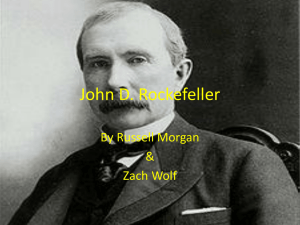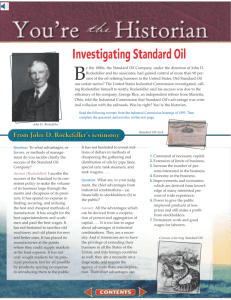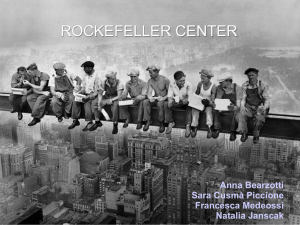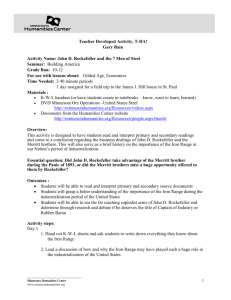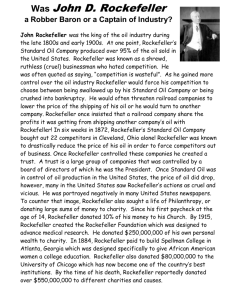BOOK REVIEWS - The Chinese University of Hong Kong
advertisement
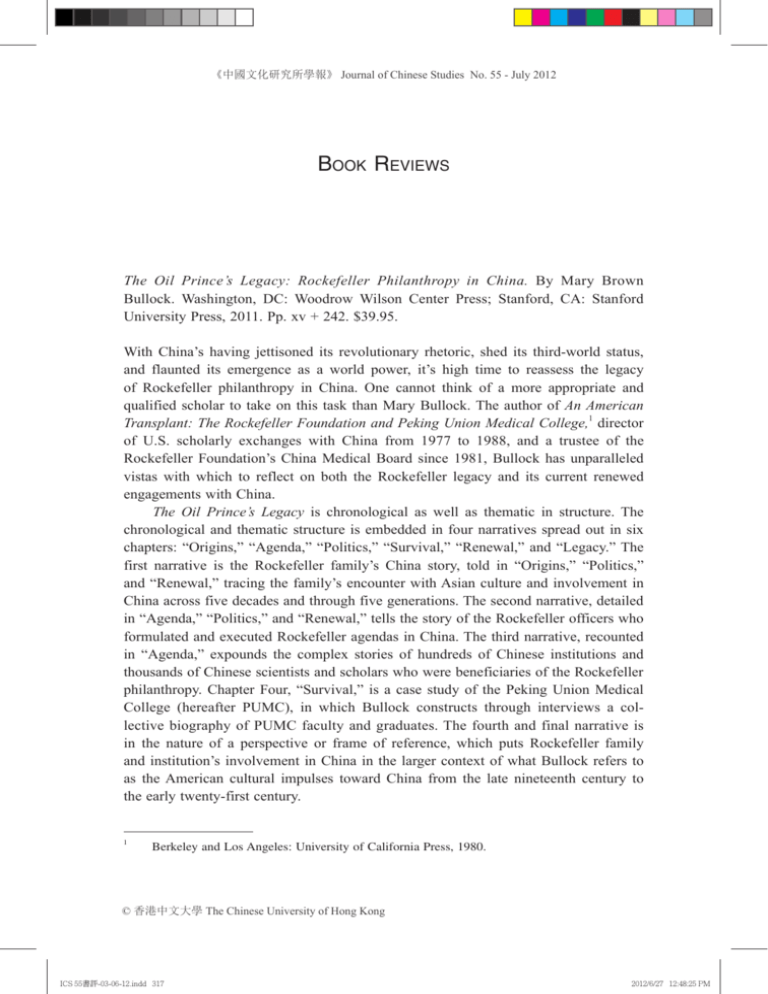
《中國文化研究所學報》 Journal of Chinese Studies No. 55 - July 2012 Book Reviews The Oil Prince’s Legacy: Rockefeller Philanthropy in China. By Mary Brown Bullock. Washington, DC: Woodrow Wilson Center Press; Stanford, CA: Stanford University Press, 2011. Pp. xv + 242. $39.95. With China’s having jettisoned its revolutionary rhetoric, shed its third-world status, and flaunted its emergence as a world power, it’s high time to reassess the legacy of Rockefeller philanthropy in China. One cannot think of a more appropriate and qualified scholar to take on this task than Mary Bullock. The author of An American Transplant: The Rockefeller Foundation and Peking Union Medical College,1 director of U.S. scholarly exchanges with China from 1977 to 1988, and a trustee of the Rockefeller Foundation’s China Medical Board since 1981, Bullock has unparalleled vistas with which to reflect on both the Rockefeller legacy and its current renewed engagements with China. The Oil Prince’s Legacy is chronological as well as thematic in structure. The chronological and thematic structure is embedded in four narratives spread out in six chapters: “Origins,” “Agenda,” “Politics,” “Survival,” “Renewal,” and “Legacy.” The first narrative is the Rockefeller family’s China story, told in “Origins,” “Politics,” and “Renewal,” tracing the family’s encounter with Asian culture and involvement in China across five decades and through five generations. The second narrative, detailed in “Agenda,” “Politics,” and “Renewal,” tells the story of the Rockefeller officers who formulated and executed Rockefeller agendas in China. The third narrative, recounted in “Agenda,” expounds the complex stories of hundreds of Chinese institutions and thousands of Chinese scientists and scholars who were beneficiaries of the Rockefeller philanthropy. Chapter Four, “Survival,” is a case study of the Peking Union Medical College (hereafter PUMC), in which Bullock constructs through interviews a collective biography of PUMC faculty and graduates. The fourth and final narrative is in the nature of a perspective or frame of reference, which puts Rockefeller family and institution’s involvement in China in the larger context of what Bullock refers to as the American cultural impulses toward China from the late nineteenth century to the early twenty-first century. 1 Berkeley and Los Angeles: University of California Press, 1980. © 香港中文大學 The Chinese University of Hong Kong ICS 55書評-03-06-12.indd 317 2012/6/27 12:48:25 PM 《中國文化研究所學報》 Journal of Chinese Studies No. 55 - July 2012 318 Book Reviews Chapter One, “Origins,” traces the evolution of the Rockefeller family’s interests in China in the larger context in which oil, medicine, and art intersected. John D. Rockefeller’s interests in promoting education for the blacks and in advancing scientific medicine lay the foundation for the future directions of the Rockefeller philanthropy. His business interests in selling oil—the kerosene lamps—to the Chinese, when stimulated and combined with his missionary impulses, sowed the seeds of the family’s enduring philanthropic as well as artistic interests in China. Under John D. Rockefeller, Jr., who led the Rockefeller philanthropic work until World War II, the Rockefeller Foundation (hereafter RF) began its intensive involvement in China. His 1921 trip to Asia, culminated in his attendance of the dedication ceremony of PUMC, whetted the family’s interests in Asian arts. Abby Rockefeller’s garden in Mount Desert Island, Maine, with the gate with the tiles from the Forbidden City is a testimony to that influence. Chapter Two, “Agenda,” is a masterful synthesis of current scholarship on the Rockefeller patronage of medicine, science, and the social sciences during the first half of the twentieth century until the Communist Revolution of 1949 terminated them all. Borrowing the term employed by the Latin American historian Marcus Cueto, Bullock characterizes the Rockefellers as the “missionaries of science.” She deftly surveys the proliferation and reorientation of the Rockefeller programmes in China, from the PUMC and the science programmes of its feeder schools, to public health, to the rural reconstruction, and to the social sciences. Bullock suggests that the “transpacific network of scholars who became an accepted part of the intellectual culture of the United States and the Republic of China illustrates well the cultural internationalism of this era” (p. 77). Chapter Three, “Politics,” analyzes the increasingly mature and complex engagement of the RF with a politically volatile China during the 1930s and 1940s. While the RF and John D. Rockefeller, Jr., held on to its management style of control from New York, the situations at the field increasingly made it difficult. As the Chinese beneficiaries of the RF assumed leadership positions in the nation’s public health administration, university social science departments, and the nation’s rural reconstruction projects, they were not necessarily passive players. Some of them led critique of the PUMC and its élitist medical model. Then the wars drastically complicated the situation. First, the Sino-Japanese War dispersed many of these Rockefeller beneficiaries to China’s southwest. Then the civil war that ended with the Communist victory forced them to choose between fleeing from and remaining with the victor. The RF, which had hitherto been able to carry out its programmes unencumbered by the Chinese governments, was finally forced to terminate them with the rise of the Chinese Communists. © 香港中文大學 The Chinese University of Hong Kong ICS 55書評-03-06-12.indd 318 2012/6/27 12:48:25 PM 《中國文化研究所學報》 Journal of Chinese Studies No. 55 - July 2012 Book Reviews 319 Chapter Four, “Survival,” is a case study of PUMC, its survival and legacy. More poignant, the conceptual design of China’s rural health delivery system, even the famous “barefoot doctors,” as Bullock points out, is part of the Rockefeller legacy. While most of the Rockefeller programmes disappeared after the Communist takeover, PUMC survives not only as an institution, but also as a model of medical education and research. In fact, what is the most striking about PUMC is not change but remarkable continuity—the preservation in a Communist system of the original Johns Hopkins élite model of medical training that linked basic research, clinical training, and full-time professional practice. In this chapter, Bullocks seeks to understand the ways in which PUMC perpetuated its identity and the role it has played in the PRC. She first looks at the period from 1951 to 1979: the careers of the first cohort of PUMC graduates, the fate of Rockefeller-funded public health programmes, and the political challenges to the PUMC leadership group. Then she turns to the postCultural Revolution period (1979 to the present), the Reform era, and examines new challenges to PUMC. Chapter Five, “Renewal,” deals with the re-entry of the RF in China. The renewed engagement of the RF with China, however, takes place in an environment completely from the earlier era. Not only do the Rockefeller philanthropies now face a Chinese government that vigilantly guards its sovereignty and provides ample funding for its research institutions, but they also pale by comparison with the U.S. government programmes that in terms of the scale and global reach are beyond the capacities of any private foundations. This chapter first discusses the diplomatic thaw between the U.S. and China that made it possible for the RF to renew its engagement with China. Then it analyzes the new China programmes initiated by three Rockefeller philanthropies—the RF, the China Medical Board, and the Rockefeller Brothers Fund. As nongovernmental organizations promoting science and medicine, these foundations were immune from the ups and downs in the U.S.-China relations during the 1980s and 1990s, Bullock points out. Chapter Six, being the concluding chapter, is appropriately devoted to the “Legacy” of the Rockefeller philanthropies in China. On 14 October 2007, Richard Rockefeller, the son of David Rockefeller—the fourth generation—and chairman of the Rockefeller Brothers Fund, attended the ninetieth anniversary of the founding of PUMC. On this occasion, PUMC commissioned and dedicated a bust of John D. Rockefeller, Sr., which is exactly 1.917 meters high—signifying the year that PUMC opened. History has come full circle. John D. Rockefeller, Sr., once vilified as an icon American economic and cultural imperialism, is now celebrated in China as a model entrepreneur. In the context of China’s rise, the Rockefeller philanthropies have begun to redefine their missions. The RF has terminated its programmes in China and shifted its focus to address problems related to poverty and underprivileged groups in Africa © 香港中文大學 The Chinese University of Hong Kong ICS 55書評-03-06-12.indd 319 2012/6/27 12:48:25 PM 《中國文化研究所學報》 Journal of Chinese Studies No. 55 - July 2012 320 Book Reviews and Asia. The China Medical Board, which used to be a division of the RF managing PUMC, has reached beyond élite medical institutions to develop a new network of provincial medical institutions that promote innovative medical training programmes for rural China. The Rockefeller Brothers Fund, created in 1940, is currently the only Rockefeller philanthropy that has dramatically increased its investment in China. During the 1990s, the Rockefeller Brothers Fund initiated programmes to empower local civic organizations in southern China to address issues related to environment and health, and energy and climate change. Times have changed. The weak and vulnerable China that the Rockefeller philanthropy first encountered a century before is now poised to assume a superpower status. If to change China domestically was the intention of the Rockefeller philanthropy before, a more appropriate term to use now would be, suggests Bullock, to engage China in the world. Bullock should be congratulated for having produced this fine piece of work. Writing The Oil Prince’s Legacy thirty years after her own pioneering work on the PUMC, she is uniquely qualified to reassess the Rockefeller legacy in China from the vintage point of China’s rise in the early twenty-first century. The effortlessness with which she weaves the various threads together into a seamless story belies the painstaking research, extensive reading, and percipient thinking that produced this work. It is a compelling story told with deep empathy and without compromising her critical stance. Bullock handles with sensitivity the revisionist interpretations that are currently in vogue in China about China’s interactions with the West during the twentieth century in general and with the Rockefeller philanthropy in particular. This revisionist turn is understandable given that decades of opening and economic reforms have engendered a penchant to question old interpretations, particularly the hangovers from the heyday of Communism. Thus, while old interpretations painted a sinister picture of the Rockefeller philanthropy and its programmes in China, the revisionist interpretations stress its positive contributions. More poignant are the collective memories of those who were persecuted during the heyday of Communism. That PUMC graduates are fixated on its vaunted “Johns Hopkins” élitist medical education model is of no surprise. Many other persecuted groups have exhibited similar tendency to glorify the legacy that had been viciously denounced. Collective memories that seemingly conform to official ideologies while in defiance of them play more than a therapeutic role for the persecuted in their recuperation process. They function as counter-discourses as well. While Bullock understandably does not address the issue of collective memories as therapy or counter-discourse, she weaves them into her story. In so doing, she gives voice to the PUMC graduates who had for decades laboured under a stigma imposed on them. Their contributions constitute part of the legacy of the Rockefeller © 香港中文大學 The Chinese University of Hong Kong ICS 55書評-03-06-12.indd 320 2012/6/27 12:48:25 PM 《中國文化研究所學報》 Journal of Chinese Studies No. 55 - July 2012 Book Reviews 321 philanthropy in China. Whether we agree with them or not about the PUMC legacy as they remember it, they deserve to be heard. Works on philanthropic foundations are voluminous. Philanthropies and their impact on society and culture will continue to be scrutinized and debated. The Oil Prince’s Legacy is a welcome addition to this literature. By looking at the Rockefeller philanthropies across the twentieth century’s longue durée, particularly with the muchheralded China’s rise in the foreground, Bullock has offered us a study that compels us to look beyond case studies and think in long terms. History moves on, and so are our perspectives. The Dynamics of Masters Literature: Early Chinese Thought from Confucius to Han Feizi. By Wiebke Denecke. Harvard-Yenching Institute Monographs 74. Cambridge, MA and London, England: Harvard University Asia Center, 2011. Pp. viii + 370. $39.95/£29.95. The Dynamics of Masters Literature is a study of early Chinese non-historical “masters” prose literature in a new key. However, when the title of the books seems to refer to a person called Han Feizi 韓非子 (Master Han Fei) it has to be said that Han Fei was the name of the man, and Han Feizi was the name of the book. (Hanzi 韓 子 is first attested, as far as I know, in Huainanzi 淮南子 chapter 11, and nowhere in pre-Han times. And one notes by the way that Huainanzi seems never to be used a personal name of Liu An 劉安.) It is true that we have plenty of early Zengzi 曾子 (Master Zeng), Mengzi 孟 (Master Meng), and Mozi 墨子 (Master Mo). But even Xunzi 荀子 is not called 子 by that name anywhere in the book which today bears his name. In chapter 15 of that book he is indeed persistently referred to as Sun Qingzi 孫卿子 , elsewhere three times in the adjacent chapter 16, and in addition there is one stray example in chapter 8. The personal name Xunzi is attested in the Eastern Han Zhong lun 中論 chapter 18, but still absent in Hanshu 漢書, “Yiwenzhi” 藝文志 (Treatise of Arts and Letters) which only tells of the book Sun Qingzi 孫卿子 which on this matter observes an imperial taboo. Han Fei is referred to as Han Fei and not as Han Feizi, just as Gongsun Long 公 孫龍 seems to be referred to as Gongsun Long and the eponymous book as the Gongsunlongzi 公孫龍子. Zisizi 子思子 seems to refer to a book attributed to Zisi, © 香港中文大學 The Chinese University of Hong Kong ICS 55書評-03-06-12.indd 321 2012/6/27 12:48:25 PM
